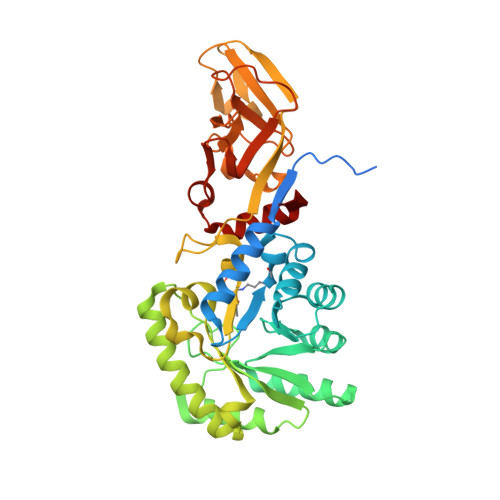Crystal structures of lysine-preferred racemases, the non-antibiotic selectable markers for transgenic plants
Wu, H.M., Kuan, Y.C., Chu, C.H., Hsu, W.H., Wang, W.C.(2012) PLoS One 7: e48301-e48301
- PubMed: 23118975
- DOI: https://doi.org/10.1371/journal.pone.0048301
- Primary Citation of Related Structures:
4DYJ, 4DZA, 4FS9 - PubMed Abstract:
Lysine racemase, a pyridoxal 5'-phosphate (PLP)-dependent amino acid racemase that catalyzes the interconversion of lysine enantiomers, is valuable to serve as a novel non-antibiotic selectable marker in the generation of transgenic plants. Here, we have determined the first crystal structure of a lysine racemase (Lyr) from Proteus mirabilis BCRC10725, which shows the highest activity toward lysine and weaker activity towards arginine. In addition, we establish the first broad-specificity amino acid racemase (Bar) structure from Pseudomonas putida DSM84, which presents not only the highest activity toward lysine but also remarkably broad substrate specificity. A complex structure of Bar-lysine is also established here. These structures demonstrate the similar fold of alanine racemase, which is a head-to-tail homodimer with each protomer containing an N-terminal (α/β)(8) barrel and a C-terminal β-stranded domain. The active-site residues are located at the protomer interface that is a funnel-like cavity with two catalytic bases, one from each protomer, and the PLP binding site is at the bottom of this cavity. Structural comparisons, site-directed mutagenesis, kinetic, and modeling studies identify a conserved arginine and an adjacent conserved asparagine that fix the orientation of the PLP O3 atom in both structures and assist in the enzyme activity. Furthermore, side chains of two residues in α-helix 10 have been discovered to point toward the cavity and define the substrate specificity. Our results provide a structural foundation for the design of racemases with pre-determined substrate specificity and for the development of the non-antibiotic selection system in transgenic plants.
Organizational Affiliation:
Institute of Molecular and Cellular Biology and Department of Life Science, National Tsing Hua University, Hsinchu, Taiwan.















